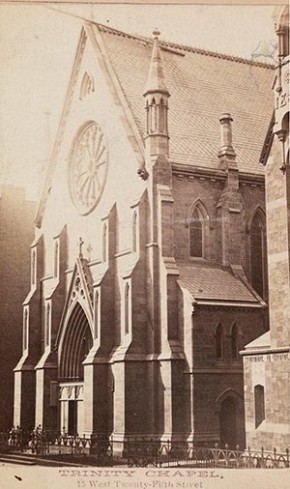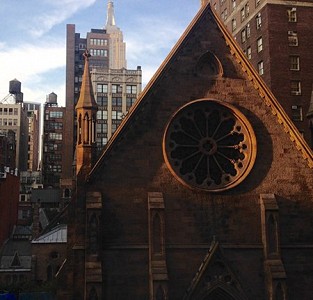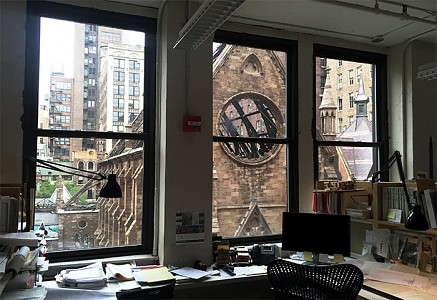Since 1986, BKSK has shared the block on West 25th Street with the Cathedral of St. Sava. Its presence in our urban view has been a steady reminder of architectural traditions that we treasure and strive to honor. Even more than that, the church has been a quietly reassuring presence in our lives, including on the morning we witnessed the destruction of the World Trade Center. An echo of the havoc wrought that day has come to our block and our church. From our fourth floor windows, we are now able to ponder the remains, and we can begin to hope for some form of a revival.
So, for those of us who now say to themselves, “Maybe I should have looked a little harder, or gone inside when the building was open, and perhaps been more aware of the work of Richard Upjohn,” here is some background on its history and recent past.
Eighteen years ago, as reported by The New York Times, an extensive restoration of the Serbian Orthodox Cathedral of St. Sava began, estimated then to cost $5 million and be carried out over years. There were weed trees growing on the bell tower. Inside, the nave’s Norwegian Pine hammerbeam trusses were rotted and needed replacement. Deteriorated metal drains, hidden from sight between the brownstone outer walls and limestone interior walls, funneled water into the building. The facade had become a demonstrative mural about the effects of urban air pollution. The congregation was celebrating the Orthodox Easter liturgy when that story ran, just as they were the day of the fire.
In a period when countless parishes in this city have had to reckon with their future in their historic buildings, the Serbian community’s commitment to restoring their Landmark-designated ecclesiastical home has been remarkable, especially considering the building’s architectural complexity. It was hand-constructed by immigrant artisans whose craft is now lost to time, with materials that can no longer be sourced. With the help of preservation grants, loans and fundraising, the modestly-sized congregation completed multiple phases of their restoration master plan. They were loyal stewards of a church built in a previous era for a different faith community.
The building they inherited was consecrated in 1855 as Trinity Chapel to serve as an uptown outpost for the northward-bound congregants of Trinity Church, the oldest Episcopalian parish in the city that was founded at the foot of Wall Street on Broadway in lower Manhattan in 1697. In the years leading up to the Civil War, Madison Square area was the center of New York society and Trinity Chapel was one of the most socially prominent churches in town. It hosted the weddings of Astors, Rhinelanders, Gardiners, and the funerals of politicians Roscoe Conkling and John Jay. A particularly notable Trinity Chapel bride was Edith Jones Wharton, the novelist and critic of Gilded Age ostentatiousness and elitism, who would recall the Madison Square neighborhood of her youth in her Pulitzer Prize-winning book, The Age of Innocence.
The architect of Trinity Chapel was Richard Upjohn, who also designed Trinity’s mother church at Broadway and Wall, itself completed in 1846 even as many parishioners were migrating uptown. For both, Upjohn found inspiration in medieval English parish churches. Responding to the narrow site on West 25th Street, Upjohn incorporated a pair of blind arcades along the sides of the nave to suggest them instead. In lieu of a traditional bell tower, a large wheel window dominates the otherwise simple, “rugged” brownstone front. He chose pure, honest materials that showcased the artisans’ craft—hand-carved trusses and hand-dressed Caen (pronounced “kahn”) limestone, which covered the entire interior and was the cause of cost overruns. It was worth it; the interior has been widely considered to be Upjohn’s masterpiece.
The Chapel building was soon after paired on the site with a Jacob Wrey Mould-designed 1860 High Victorian polychromatic school building, which still stands forty feet east of the chapel and now serves as a parish hall. Mould is best remembered for his work with Calvert Vaux in Central Park. By 1866, a clergy house was attached to the rear of the chapel on 26th Street. Together, a graceful and well-used through-block complex with extraordinary architectural detail was created and became a centerpiece of the neighborhood.
Trinity’s presence here wasn’t to last; society’s northward momentum continued. By the turn of the century the neighborhood was transforming into a mercantile district with the rowdy Tenderloin District to the west mixing in. By 1912, most all of the block’s Italianate brownstones had been replaced with ten-to-twelve-story commercial loft buildings. Trinity Chapel, after a brief lull in the 1910s, found renewed vigor in the interwar years, but by 1943, the vestry had decided it was time to sell. Their choice of the fledgling Serbian Eastern Orthodox Church of St. Sava as their buyer was an appropriate one. For a special occasion in 1865, Trinity Chapel hosted an Orthodox liturgy, the first Episcopalian church in American ever to do so.
For over 70 years, the Cathedral of St. Sava on 25th Street has served as the spiritual heart of the Serbian community of New York, yet they respected Upjohn’s Western architecture. Their biggest imprint was the 1962 installation of a sacred Byzantine sanctuary screen from Yugoslavia and the installation of new stained-glass altar windows to replace the older ones that had been blown-out in a 1966 bombing at the Communist Party of the U.S. headquarters, then located across the street on 26th Street. Beyond that, Upjohn’s original design was kept intact—even the pews, which the Eastern Orthodox liturgy does not call for. In 1968, they supported the nascent Landmarks Preservation Commission move to designate the complex, recognizing “that, among its important qualities, the Serbian Orthodox Cathedral of St. Sava and Clergy House and Parish House are outstanding examples of Gothic Revival architecture, that they are straight-forward expressions of masonry bearing-wall church construction, that they are striking in appearance and command attention, and that taken together they form an attractive group, revered and honored by their congregation.” That same year, the complex was also listed on the National Register of Historic Places.
Among the many qualities described in the designation report, and the details painstakingly restored that are now gone or threatened, we at BKSK can add our own mental footnotes, based on 30 years of proximity. Perhaps the most unexpected and ethereal quality of the building, observable only in winter, was the way snow would collect on the steeply sloping slate roof, but only so far. Mini-avalanches were seemingly random, delightfully unpredictable, and frequent. It often seemed that Richard Upjohn was reaching out across the years to break our design focus.
We marvel, though, at the determinedly un-ethereal resilience of the yet-standing masonry walls, and recognize the stirring of hope that they signal all is not lost.



